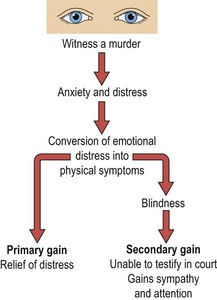Dissociative and somatoform disorders
Dissociative (conversion) disorders
Aetiology
Dissociation and conversion can lead to primary and secondary gain, as shown in Figure 1. In chronic cases, secondary gain is often a maintaining factor.
Management
Dissociative disorder must always be a positive diagnosis, based upon a history that provides some reasonable psychological explanation of how and why the problem developed. The patient may deny recent stressful events and problems or disturbed relationships, so it is important to seek information from others. Great care must be taken to exclude organic pathology and it should be remembered that follow-up studies of people diagnosed with dissociative disorders have found that many turned out to have an underlying physical condition. Catatonic schizophrenia and severe depressive episodes should be considered in cases of stupor. Two further differential diagnoses are factitious disorder, also known as Munchausen’s syndrome, and malingering, the major features of which are shown in Figure 2.
< div class='tao-gold-member'>
Stay updated, free articles. Join our Telegram channel

Full access? Get Clinical Tree





